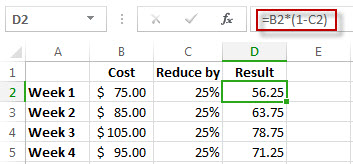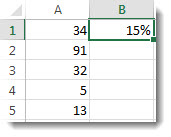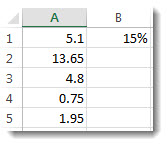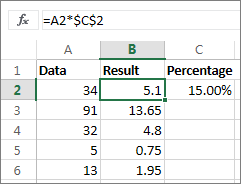Note: If you need to find the percentage of a total or find the percentage of change between two numbers, you can learn more in the article Calculate percentages.
Change an amount by a percentage
Let's say you need to decrease—or want to increase—your weekly food expenditures by 25%. To calculate the amount, use a formula to subtract or add a percentage.
In this example, we set column B to contain the amount currently spent, and column C is the percentage by which to reduce that amount. Here's is a formula you could enter in cell D2 to accomplish this:
=B2*(1-C2)
In this formula, 1 is equivalent to 100%. The values inside the parentheses calculate first, so ther value of C2 is subtracted from 1, to give us 75%. The result is multiplied by B2 to get a result of 56.25 for Week 1.

To copy the formula in cell D2 down the column, double-click the small square green box in the lower-right corner of cell D2. You get the results in all of the other cells without retyping or copying-and-pasting the formula.
To increase the amount by 25%, simply replace the + sign in the formula in cell D2 sign to a minus (-):
=B2*(1+C2)
Then double-click the fill-down handle again.
Multiply an entire column of numbers by a percentage
Consider an example table like the one in the figure, in which we've got a few numbers to multiply by 15 percent. Even if the column has 100 or 1,000 cells of data, Excel can still handle it in a few steps.

Here’s how to do it:
-
Enter the numbers you want to multiply by 15% into a column.
-
In an empty cell, enter the percentage of 15% (or 0.15), and then copy that number by pressing Ctrl-C.
-
Select the range of cells A1:A5 (by dragging down the column).
-
Right-click over the cell selection, and then click Paste Special (do not click the arrow next to Paste Special).

-
Click Values > Multiply, then click OK.
The result is that all the numbers are multiplied by 15%.

Tip: You can also multiply the column to subtract a percentage. To subtract 15%, add a negative sign in front of the percentage, and subtract the percentage from 1, using the formula =1-n%, in which n is the percentage. To subtract 15%, use =1-15% as the formula.
Multiply an entire column of numbers by a percentage
In this example, we’ve got just a few numbers to multiply by 15 percent. Even if the column has 100 or 1000 cells of data, Excel for the web can still handle it in a few steps. Here’s how:

-
Type =A2*$C$2 in cell B2. (Be sure to include the $ symbol before C and before 2 in the formula.)
The $ symbol makes the reference to C2 absolute, which means that when you copy the formula to another cell, the reference will always be to cell C2. If you didn't use $ symbols in the formula and you dragged the formula down to cell B3, Excel for the web would change the formula to =A3*C3, which wouldn't work, because there is no value in C3.
-
Drag the formula in B2 down to the other cells in column B.
Tip: You can also multiply the column to subtract a percentage. To subtract 15%, add a negative sign in front of the percentage, and subtract the percentage from 1, using the formula =1-n%, where n is the percentage. So to subtract 15% use =1-15% as the formula.










